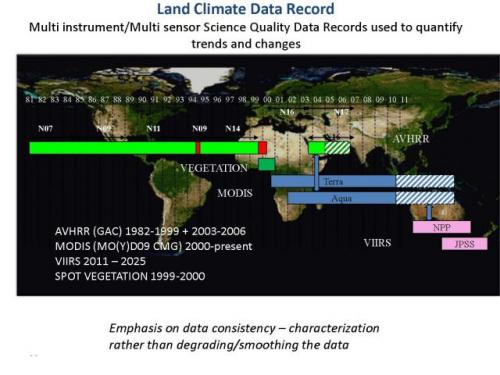The overall objective of this project is to produce, validate and distribute a global land surface climate data record (CDR) using a combination of mature and tested algorithms and the best available polar-orbiting satellite data from 1981-2009 which can be extended into the NPOESS era. The data record consists of one fundamental climate data record (FCDR), the surface reflectance product. Two Thematic CDR’s (TCDRs) are also derived from the FCDR, the normalized difference vegetation index (VI) and LAI/fAPAR. These two products are used extensively for climate change research and are listed as Essential Climate Variables (ECVs) by GCOS. In addition, these products are used in a number of applications with long-term societal benefit. The two TCDRs are used to assess the performance of the FCDR through a rigorous validation program and provide feedback on requirements for the Surface Reflectance FCDR.
The record uses the best available data, addressing the dynamic data continuity of the input observations, which are primarily from the AVHRR and MODIS with differing spatial resolutions 4km GAC (1981–2009), 1km HRPT and LAC (1992–1998), 250m to 1km MODIS (2000-2009). A gap in the data record from these two instruments for the 1999-2000 is filled using a SPOT VEGETATION surface reflectance product (1km) generated by European GEOLAND2 project. The resulting product is a consistent climate data record of the Land surface from 1981 to 2009.
The experience of the team in producing high quality coarse resolution land datasets through the use of physically based methods for calibration, geolocation and atmospheric correction is unparalleled. The multi-agency composition of the team helped in the process of building a broad community consensus for the FCDR. The availability of the MODIS and AERONET record for intercomparison and the reuse of the MODIS Processing and Quality Assurance approaches are key to producing a long-term data record from AVHRR and MODIS. Special attention was paid to product validation and developing realistic uncertainties needed for optimal exploitation of TCDRs. The validation was linked to and benefited from previous and on-going international validation activities of the CEOS Land Product Validation Working Group. The data distribution was undertaken by the MODAPS group at NASA GSFC utilizing the Land and Atmospheres Archive and Distribution System (LAADS).
This proposal built on the investigators’ experience in developing long-term land data records under the NASA REASON LTDR project, which provides the mechanisms for adaptation of peer-reviewed algorithms, the product generation, distribution, validation and quality control of the Climate Data Record.


